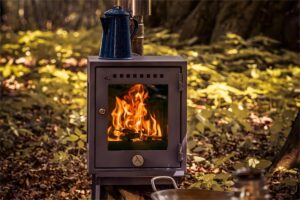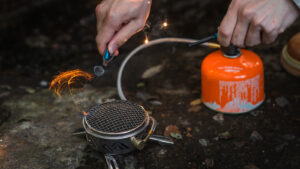
A wood-burning camping stove is a compact, portable burner that uses wood to provide heat. Depending on the type of wood-burning camping stove you purchase, you will find a set of feet to raise the stove off the ground, a small door through which you can add firewood, folding shelves that fold out from the body of the stove (to be used for heating food/drink), and a chimney.
What features should wood burning camping stoves have?
As you’ve read, there are several compelling reasons to invest in wood-burning camping stoves. However, in order to get the best wood-burning camping stoves, you should consider some key qualities.
We’ve outlined these crucial aspects below:
Steel construction
Firstly, be sure that the wood-burning camping stove you choose is built of steel. This ensures that you have a well-built stove that will withstand the test of time. While it may be tempting to buy a lighter aluminum stove, we recommend against it since metal dents quickly and does not last as long.
Legs
To get the maximum heating performance out of your camping stove, keep air moving around it at all times, even beneath. So, make sure the stove you choose has foldable or removable legs. These will keep your stove off the chilly ground and help keep it stable on uneven surfaces. With legs, a stove will be at a higher height, making it simpler to operate.
Large burn compartment
You don’t want to have to keep tossing sticks and little logs into your stove. So, ensure that the stove you choose has a large enough burn chamber. We’re not talking cavernous here; just enough for a few small logs and thicker branches.
Cooktop
For the whole camping experience, you should be able to use your burner for both cooking and heating. So, seek for versions with a ‘cooktop’. This simply refers to a flat, sturdy region on top of the stove body that may hold a frying pan, kettle, or pot.
Flue
Your wood-burning camping stove must have a high-quality chimney pipe. A chimney flue is necessary to work properly since it channels smoke and other combustible materials up and away from your camping location (after all, you don’t want your tent or caravan to smell like smoke). The flue will also generate the ‘draw’ that is required for your stove to perform properly, while the chimney will assist in drawing air into the core of the fire. When shopping for camping stoves with flues, we strongly advise you to consider models with a foldable flue. These sorts of flues are simply disassembled and stowed in the burn compartment during transportation.
Removable top plate
Would you like to be able to cook over an open fire? Then choose a wood-burning camping stove with a detachable top plate. This allows you to cook directly over the flames of the fire that is raging within the stove. Perfect for marshmallows. A detachable top plate is useful for swiftly heating water in a pot.
Air vents/dampers
To properly control the fire in a camping stove, you must be able to adjust the amount of oxygen that reaches it.
The easiest method to accomplish this is to install air vents or dampers. So, be sure you get a wood-burning camping stove that has these advantages. On camping stoves, the air vent(s) are normally located on the stove door. This allows you to better assess how the fire is going and if you need to raise or reduce the flow of air to the core of the fire.
Portability
You’ll also want to ensure that the wood-burning camping stove you purchase is portable. After all, if you’re camping, you’ll want to be able to pack the stove into your car at the start and conclusion of your trip.
So seek for versions that can be disassembled into different sections, making them easy to transport and store.
The best camping stoves
Canister camping stoves
Canister stoves are simple to operate, need little maintenance, and can be quite lightweight, making them the most frequent form of camping stove you’ll find up in the hills. Simply put the burner head into the gas canister, ignite, and go, as with the MSR Pocket Rocket Deluxe. The disadvantages include stability concerns, which can be mitigated by broad, serrated pan supports, and difficulty determining the amount of gas remaining in your canister, necessitating the use of a backup canister.
Wood-burning camping stoves
Wood stoves are popular among bushcraft enthusiasts and can be a lot of fun to use, as the Solo Stove Titan demonstrates. They can be simple and lightweight – you find your fuel (twigs and dry wood) in nature – and are frequently made of materials such as titanium and can fold flat. However, they are less trustworthy and are likely to be avoided by individuals concerned about wildfire or forest loss. Similarly, damp weather might make it difficult to obtain dry wood.
Alcohol stoves
Alcohol is simple and light. The finest designs include a windshield as well as pot support, which can result in faster boil times. Indeed, this style takes longer to boil water than gas, has less change in flame strength for simmering, and the alcohol fuel reserves are large during extended trips. However, they are quiet, low-cost to operate, can be more ecologically friendly, and provide a back-to-basics experience.
Liquid and multifuel camping stoves
This style, such as the Optimus Polaris Opti fuel, may run on white gas or paraffin, petrol, diesel, or even aviation (jet) fuel. They may be quite strong and are even effective in melting snow in winter camps. They are also a solid solution for international backpackers, as well as treks to distant places of the world where gas may not be accessible. However, they are likely to be significantly heavier than a canister stove and will require more priming and maintenance.
ODM service
Looking for reliable camping stove supplier? At Deermaple, we specialize in ODM service, offering high-quality and innovative stoves tailored to your needs.
If you are interested in camping stove wholesale , please contact us.










